I'm currently downloading stock data using GetSymbols from the Quantmod package and calculating the daily stock returns, and then combining the data into a dataframe. I would like to do this for a very large set of stock symbols. See example below. In stead of doing this manually I would like to use a For Loop if possible or maybe use one of the apply functions, however I can not find the solution.
This is what I currently do:
Symbols<-c ("XOM","MSFT","JNJ","GE","CVX","WFC","PG","JPM","VZ","PFE","T","IBM","MRK","BAC","DIS","ORCL","PM","INTC","SLB")
length(Symbols)
#daily returns for selected stocks & SP500 Index
SP500<-as.xts(dailyReturn(na.omit(getSymbols("^GSPC",from=StartDate,auto.assign=FALSE))))
S1<-as.xts(dailyReturn(na.omit(getSymbols(Symbols[1],from=StartDate,auto.assign=FALSE))))
S2<-as.xts(dailyReturn(na.omit(getSymbols(Symbols[2],from=StartDate,auto.assign=FALSE))))
S3<-as.xts(dailyReturn(na.omit(getSymbols(Symbols[3],from=StartDate,auto.assign=FALSE))))
S4<-as.xts(dailyReturn(na.omit(getSymbols(Symbols[4],from=StartDate,auto.assign=FALSE))))
S5<-as.xts(dailyReturn(na.omit(getSymbols(Symbols[5],from=StartDate,auto.assign=FALSE))))
S6<-as.xts(dailyReturn(na.omit(getSymbols(Symbols[6],from=StartDate,auto.assign=FALSE))))
S7<-as.xts(dailyReturn(na.omit(getSymbols(Symbols[7],from=StartDate,auto.assign=FALSE))))
S8<-as.xts(dailyReturn(na.omit(getSymbols(Symbols[8],from=StartDate,auto.assign=FALSE))))
S9<-as.xts(dailyReturn(na.omit(getSymbols(Symbols[9],from=StartDate,auto.assign=FALSE))))
S10<-as.xts(dailyReturn(na.omit(getSymbols(Symbols[10],from=StartDate,auto.assign=FALSE))))
....
S20<-as.xts(dailyReturn(na.omit(getSymbols(Symbols[20],from=StartDate,auto.assign=FALSE))))
SPportD<-cbind(SP500,S1,S2,S3,S4,S5,S6,S7,S8,S9,S10,S11,S12,S13,S14,S15,S16,S17,S18,S19,S20)
names(SPportD)[1:(length(Symbols)+1)]<-c("SP500",Symbols)
SPportD.df<-data.frame(index(SPportD),coredata(SPportD),stringsAsFactors=FALSE)
names(SPportD.df)[1:(length(Symbols)+2)]<-c(class(StartDate),"SP500",Symbols)
Any suggestions?
Thanks!
